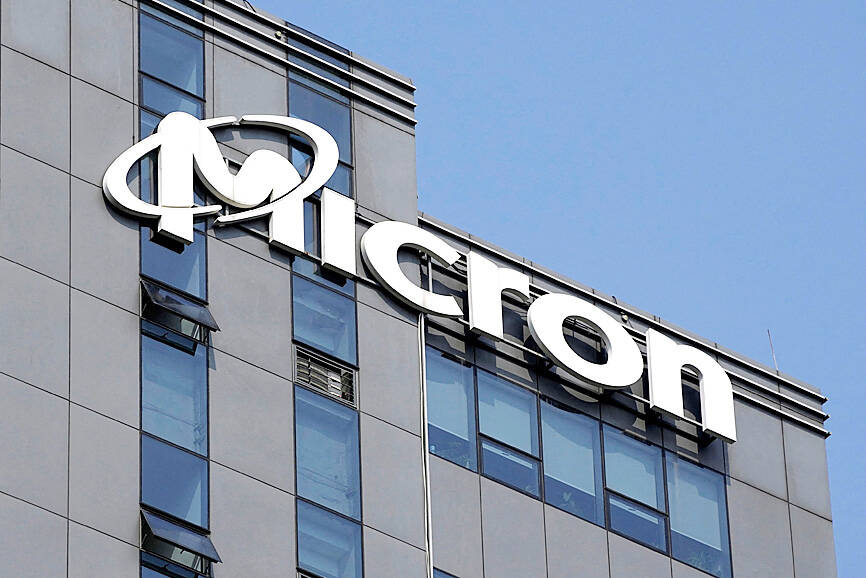Micron Technology Inc, the largest US memorychip maker, on Wednesday offered a surprisingly strong revenue forecast for the current quarter, buoyed by demand for artificial intelligence (AI) hardware.
Fiscal third-quarter revenue would be US$6.4 billion to US$6.8 billion, the company said in a statement. That compares with an average analyst estimate of US$5.99 billion.
Micron would have earnings per share of about US$0.45, minus certain items. Analysts projected US$0.24.

Photo: Reuters
Micron and its rivals are emerging from one of the worst slumps the memorychip industry has suffered, triggered by weak demand for PCs and smartphones, but executives are optimistic about the future as the booming market for AI equipment helps chipmakers return to growth and profitability.
“We believe Micron is one of the biggest beneficiaries in the semiconductor industry of the multi-year opportunity enabled by AI,” Micron chief executive officer Sanjay Mehrotra said in the statement.
Mehrotra has promised investors that this year would mark a rebound for the industry and next year would see record sales levels, but Micron would need to make enough ultrafast memory, which works with Nvidia Corp chips to help data center operators develop AI software.
AI-related systems use high-bandwidth memory (HBM). That type of chip is new and less of a commodity. That means Micron can charge a much higher price.
Micron got its first revenue from a form of this memory known as HBM3E in its most recent quarter. The semiconductors are part of Nvidia graphics chip-based AI accelerators, the company said.
The company expects “several hundred million” dollars of revenue from HBM products this year. The majority of its production of such chips is sold out for next year, it said.
Nvidia chief executive officer Jensen Huang (黃仁勳) on Monday said that HBM was more than just a memory upgrade — it is a technical marvel that is vital to AI systems. He mentioned Micron as a leader in bringing the new technology to market.
In the second quarter, which ended on Feb. 29, Micron’s revenue rose 58 percent to US$5.82 billion. The Boise, Idaho-based firm had earnings per share of US$0.42, excluding certain items. That compares with estimated sales of US$5.35 billion and a projected loss per share of US$0.24.
“Micron has returned to profitability and delivered positive operating margin a quarter ahead of expectation,” Mehrotra said on a conference call with analysts.
The company said it is maintaining its budget for new plants and equipment for this year at US$7.5 billion to US$8 billion.
It is to proceed with projects in China, Japan and India, while proposed US expansions “require Micron to receive the combination of sufficient CHIPS and Science Act grants, investment tax credits and local incentives to address the cost difference” compared with overseas expansion, Mehrotra said.

Hon Hai Precision Industry Co (鴻海精密) yesterday said that its research institute has launched its first advanced artificial intelligence (AI) large language model (LLM) using traditional Chinese, with technology assistance from Nvidia Corp. Hon Hai, also known as Foxconn Technology Group (富士康科技集團), said the LLM, FoxBrain, is expected to improve its data analysis capabilities for smart manufacturing, and electric vehicle and smart city development. An LLM is a type of AI trained on vast amounts of text data and uses deep learning techniques, particularly neural networks, to process and generate language. They are essential for building and improving AI-powered servers. Nvidia provided assistance

STILL HOPEFUL: Delayed payment of NT$5.35 billion from an Indian server client sent its earnings plunging last year, but the firm expects a gradual pickup ahead Asustek Computer Inc (華碩), the world’s No. 5 PC vendor, yesterday reported an 87 percent slump in net profit for last year, dragged by a massive overdue payment from an Indian cloud service provider. The Indian customer has delayed payment totaling NT$5.35 billion (US$162.7 million), Asustek chief financial officer Nick Wu (吳長榮) told an online earnings conference. Asustek shipped servers to India between April and June last year. The customer told Asustek that it is launching multiple fundraising projects and expected to repay the debt in the short term, Wu said. The Indian customer accounted for less than 10 percent to Asustek’s

‘DECENT RESULTS’: The company said it is confident thanks to an improving world economy and uptakes in new wireless and AI technologies, despite US uncertainty Pegatron Corp (和碩) yesterday said it plans to build a new server manufacturing factory in the US this year to address US President Donald Trump’s new tariff policy. That would be the second server production base for Pegatron in addition to the existing facilities in Taoyuan, the iPhone assembler said. Servers are one of the new businesses Pegatron has explored in recent years to develop a more balanced product lineup. “We aim to provide our services from a location in the vicinity of our customers,” Pegatron president and chief executive officer Gary Cheng (鄭光治) told an online earnings conference yesterday. “We

LEAK SOURCE? There would be concern over the possibility of tech leaks if TSMC were to form a joint venture to operate Intel’s factories, an analyst said Taiwan Semiconductor Manufacturing Co (TSMC, 台積電) yesterday stayed mum after a report said that the chipmaker has pitched chip designers Nvidia Corp, Advanced Micro Devices Inc and Broadcom Inc about taking a stake in a joint venture to operate Intel Corp’s factories. Industry sources told the Central News Agency (CNA) that the possibility of TSMC proposing to operate Intel’s wafer fabs is low, as the Taiwanese chipmaker has always focused on its core business. There is also concern over possible technology leaks if TSMC were to form a joint venture to operate Intel’s factories, Concord Securities Co (康和證券) analyst Kerry Huang (黃志祺)